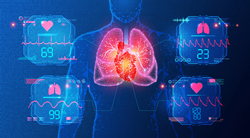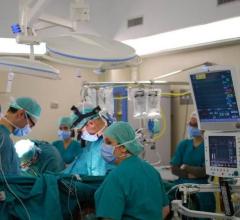
December 8, 2022 — Heart disease is the number one killer in the U.S., and high-fidelity monitoring is the beginning of new prospects for patients with congestive heart failure (CHF). Nearly five million Americans of all ages have been diagnosed with CHF, with approximately 550,000 new cases a year.(1) Stuart Long, CEO of InfoBionic says, “Cardiac care should follow the patient on a virtual journey and deliver high-fidelity insights to care providers, eliminating the gaps in data transmission.”
CHF is an imbalance in the heart’s pump function. It is a common clinical syndrome that is a significant public health problem,(2) contributing to the equivalent of one death every 90 seconds.(3) More than half of patients with CHF die within five years of diagnosis, and sudden death occurs 6 to 9 times as often among patients with CHF than in the general population.(1)
Monitoring patients with CHF is critical because, in the case of sudden cardiac arrest (SCA), time to defibrillation is a matter of life and death.(2) For every minute a patient waits for defibrillation, their chances of survival decrease 7 to 10 times.(3) Patients who receive defibrillation within two minutes after SCA have the best chance of survival. However, paramedics take an average of 9.8 minutes to arrive.(3) Reducing time to defibrillation is particularly critical because 75% to 80% of SCAs outside of a hospital happen at home.(4)
One effective solution for patients with CHF is continuous remote cardiac monitoring. It alerts the medical team in advance of SCA, thereby increasing the patient’s chances of survival. Early efforts at remote monitoring relied heavily on a patient’s participation and showed limited success. Emerging technologies using a machine learning algorithm that stream data, detected precursors of heart failure with 76% to 88% sensitivity.(5)
Virtual cardiac telemetry is a practical, noninvasive diagnostic tool. It can detect SCA early and improve the time to defibrillation. It aids in identifying deteriorating and life-threatening conditions such as non-sustained arrhythmias. It facilitates the management of arrhythmias and helps guide patient health management by identifying the cause of symptoms.(6)
Infobionic's cutting-edge solutions have nearly eliminated this communication gap. InfoBionic’s Platform allows the doctor to set customizable alerts. They can also easily and quickly scroll through the minutes and hours before and after a known cardiac event to identify the acute onset and offset data.
For patients with CHF, any undiscovered dangerous arrhythmia leaves them vulnerable. A significant problem with most monitoring equipment is that they do not alert the physician to essential biotelemetry. Instead, the physician receives 20- to 30-second electrocardiogram (ECG) strips, leaving 95% or more data lost in transmission.(7)
Physicians can now receive full-disclosure data from noninvasive heart monitors directly to their mobile devices throughout an extended monitoring period. This access to data during vital monitoring periods is a game-changer.
The legacy monitors physicians have relied on for years require the patient to return the monitor to the physician’s office or mail it back to a third-party service provider. The patient and provider wait for results — sometimes delayed by weeks — while the third party performs the analysis. This delay puts the patient at risk and fails to give the cardiologist control over the patient's data review, timing, diagnosis, and care.
InfoBionic’s MoMe Kardia system is the first comprehensive, cloud-based remote patient monitoring platform that delivers on-demand, actionable monitoring data and analytics directly to physicians. This cardiac remote patient monitoring revolutionizes the efficiency and quality of data they have to monitor patients and catch abnormal heart rhythms and cardiac symptoms before they turn deadly.
Long states, “A higher quality system and greater diagnostic yield coupled with state-of-the-art AI will allow for better implementation with improved clinician impacts to staffing and workflow versus traditional systems.”
For more information: https://InfoBionic.com/
References:
1) Emory Healthcare. “Heart Failure Statistics.” Accessed November 14, 2022, Wellness, emoryhealthcare.org/centers-programs/heart-vascular-center/wellness/heart-failure-statistics.html.
2) Gensini, Gian Franco; Alderighi, Camilla; Rasoini, Raffaele; Mazzanti, Marco; Casolo, Giancarlo. “Value of Telemonitoring and Telemedicine in Heart Failure Management.” November 2017, National Library of Medicine, ncbi.nlm.nih.gov/pmc/articles/PMC5739893/
3) Berkman, Meir. “Why Is Rapid Defibrillation Important.” Avive. Accessed November 14, 2022. avive.life/guides/importance-of-time-to-defibrillation/
4) McRae, Tagni. “CPR Facts and Statistics .” Accessed November 14, 2022, American Heart Association, zoll.com/-/media/uploadedfiles/public_site/core_technologies/real_cpr_help/cpr-fakten-pdf.
5) Mohebali D, Kittleson MM. “Remote monitoring in heart failure: current and emerging technologies in the context of the pandemic.” Heart, 2021;107:366-372. heart.bmj.com/content/107/5/366
6) Zègre-Hemsey, Jessica K. PhD, RN; Garvey, J. Lee MD; Carey, Mary G. PhD, RNc. “Cardiac Monitoring in the Emergency Department.” Crit Care Nurs Clin North Am, July 2, 2016. ncbi.nlm.nih.gov/pmc/articles/PMC5630152/
7) Long, Stuart; Movsowitz, Colin M.D. “New Technology Allows Direct Transmission of Remote Cardiac Monitoring Data.” DAIC, August 30, 2019. dicardiology.com/article/new-technology-allows-direct-transmission-remote-cardiac-monitoring-data


 March 31, 2025
March 31, 2025 









